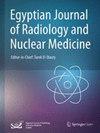Pharmacomechanical thrombectomy in management of pulmonary embolism
IF 0.5
Q4 RADIOLOGY, NUCLEAR MEDICINE & MEDICAL IMAGING
Egyptian Journal of Radiology and Nuclear Medicine
Pub Date : 2024-09-17
DOI:10.1186/s43055-024-01359-z
引用次数: 0
Abstract
Acute pulmonary embolism is recorded as one of the most common and critical medical conditions, resulting in a notable mortality rate requiring a multidisciplinary management. In this series, we address the management of massive and sub-massive pulmonary embolism utilizing catheter-based intervention, in particular the conjunction of mechanical thrombus disruption and aspiration with pharmacological thrombolysis (pharmacomechanical thrombectomy). 37 patients were diagnosed with massive and sub-massive pulmonary embolism based on the clinical and radiological findings. Pre-procedural vital parameters were obtained, including oxygen saturation, pulse rate, and blood pressure. Under continuous monitoring and conscious sedation, a pulmonary angiography via right common femoral vein access was performed for pre-procedural assessment. Pharmacomechanical thrombectomy was performed using the AngioJet Ultra System (Boston Scientific). Using the power pulse option, a fibrinolytic agent was infused into the thrombus. After 5–10 min, mechanical thrombectomy is performed with a maximum 3 passes through the thrombus. This technique is performed in the main pulmonary artery and lower branch. The procedure is repeated on the other side. The maximum duration of thrombectomy is 2–3 min on each side. Procedure success was based on improvement of vital signs and not related to post-procedure angiographic findings. All patients showed immediate improvement of vital signs (blood pressure, 02 saturation, and pulse rate) with progressive improvement over the following days. There were no procedure-related complications. Pharmacomechanical thrombectomy is a safe and effective technique in the treatment of massive and submassive pulmonary embolism. It can be a first-line treatment even in patients without absolute contraindication to systemic thrombolysis.药物机械血栓切除术在肺栓塞治疗中的应用
据记录,急性肺栓塞是最常见的危重病之一,死亡率很高,需要多学科综合治疗。在本系列研究中,我们探讨了利用导管介入治疗大面积和亚大面积肺栓塞的方法,特别是将机械性血栓破坏和抽吸与药物溶栓(药物机械血栓切除术)相结合。根据临床和放射学检查结果,37 名患者被诊断为大面积和亚大面积肺栓塞。手术前采集了生命参数,包括血氧饱和度、脉搏和血压。在持续监测和有意识镇静的情况下,通过右股总静脉通道进行了肺血管造影,以进行术前评估。使用 AngioJet Ultra 系统(波士顿科学公司)进行药物机械血栓切除术。使用功率脉冲选项,将纤维蛋白溶解剂注入血栓。5-10 分钟后,进行机械血栓切除术,最多通过血栓 3 次。这项技术在主肺动脉和下支进行。在另一侧重复该过程。每侧血栓切除术的最长持续时间为 2-3 分钟。手术成功与否取决于生命体征的改善,与术后血管造影结果无关。所有患者的生命体征(血压、血氧饱和度和脉搏)都立即得到改善,并在随后几天逐渐好转。没有出现与手术相关的并发症。药物机械取栓术是治疗大面积和亚大面积肺栓塞的一种安全有效的技术。即使是没有全身溶栓绝对禁忌症的患者,也可将其作为一线治疗方法。
本文章由计算机程序翻译,如有差异,请以英文原文为准。
求助全文
约1分钟内获得全文
求助全文
来源期刊

Egyptian Journal of Radiology and Nuclear Medicine
Medicine-Radiology, Nuclear Medicine and Imaging
CiteScore
1.70
自引率
10.00%
发文量
233
审稿时长
27 weeks
 求助内容:
求助内容: 应助结果提醒方式:
应助结果提醒方式:


